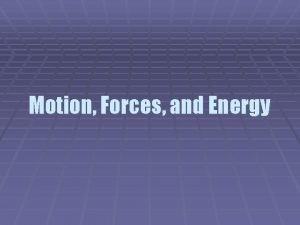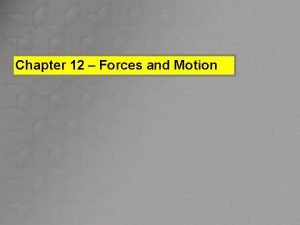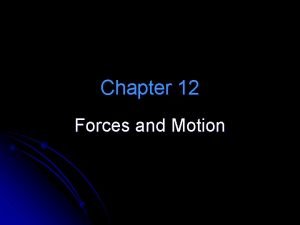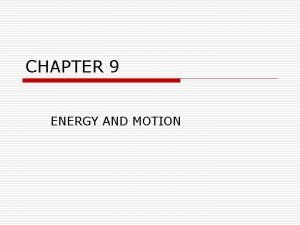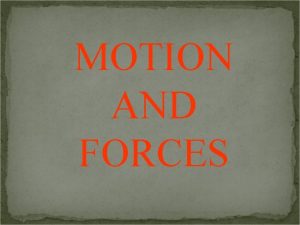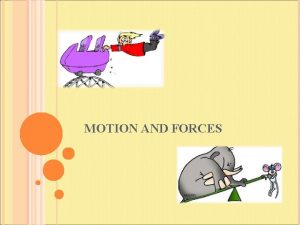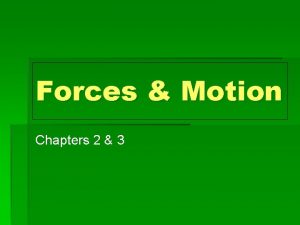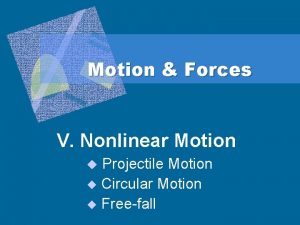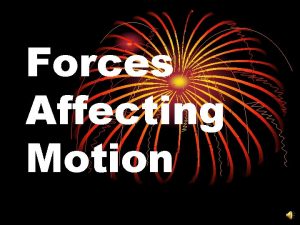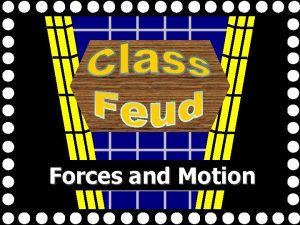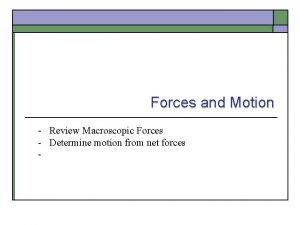ENERGY IN MOTION FORCES Chapter 13 FORCES Chapter











- Slides: 11

ENERGY IN MOTION: FORCES Chapter 13

FORCES Chapter 13 A push or a pull Forces have 2 properties § Direction § Magnitude § Newton (N) is used to describe the magnitude, or size § 1 lb. = 4. 48 N A force can be exerted without the object moving. § Ex. Force exerted when sitting on a chair

GRAVITY AND WEIGHT The force of gravity on an object is called weight. Gravity exerts 9. 8 N on every kg of mass. Mass and weight are not the same thing! § Weight is less on the moon § W = mg; m=W/g; g=W/m

FRICTION Section 3 The force that opposes the motion between two surfaces that touch The surface of any object is rough § Even surfaces that feel smooth are covered with tiny hills and valleys § Friction is greater when the surface is rougher

TYPES OF FRICTION Kinetic/sliding friction- when an object moves § kinetic = moving § Less friction between surfaces that roll than surfaces that slide Static friction- when an object doesn’t move § The greater the force squeezing two surfaces together; § the greater the Friction force.

FRICTION: HARMFUL AND HELPFUL Friction cause holes in your socks or erosion Without friction your pencil wouldn’t leave a mark on you paper or you would slip and fall when you tried to walk Sometimes it should be increased § Rougher surfaces (sand/salt added to icy roads) § Increasing force (scrubbing a dirty pan in the sink) Sometimes it should be decreased § You can apply a lubricant between two surfaces (motor oil, wax, grease) § Roll rather than slide § Smoother surfaces

FORCE VECTORS To show force we use vectors. § § Vectors have a magnitude (size) and a direction Units = Newtons Can be positive or negative Must have a scale (ex: 1 cm = 1 N)

COMBINED EFFECT OF FORCES When two or more forces act on an object the result is combined or cumulative = net force These pictures don’t show it, but the length of the arrows (vectors) should represent the magnitude of the force § The longer the vector, the larger magnitude the force § And the combined length of the force vectors should equal the length of the net force vector.

BALANCED FORCES Objects that are not moving are called static Net force = 0 aka equilibrium Normal force = the force a surface exerts on an object that is pressing on it. In many cases forces acting on static objects are tension or compression § Tension- a force that acts on an object when it is pulled or stretched § Compression- a force that is exerted when matter is pushed or squeezed

UNBALANCED FORCES Unbalanced forces cause a change in velocity of an object § May be a change in speed, direction, or both § Net force is not zero Moving objects § Can change speed or direction Nonmoving objects § Start moving Direction of movement

SUMMARY Focus your summary on motion, forces, and friction.
 Motion forces and energy
Motion forces and energy Unit 3 force motion energy answer key
Unit 3 force motion energy answer key Chapter 2 section 1 describing motion answer key
Chapter 2 section 1 describing motion answer key What is acceleration
What is acceleration Section 1 describing motion answer key
Section 1 describing motion answer key Chapter 12 forces and motion
Chapter 12 forces and motion Chapter 12 forces and motion
Chapter 12 forces and motion Energy energy transfer and general energy analysis
Energy energy transfer and general energy analysis Energy energy transfer and general energy analysis
Energy energy transfer and general energy analysis Section 1 describing motion
Section 1 describing motion Range of motion definition
Range of motion definition Simple harmonic motion formulas
Simple harmonic motion formulas
